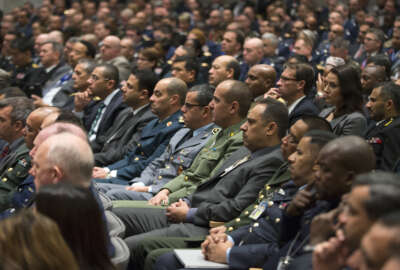
A long-running national security entrepreneurs network keeps growing
A collegiate-level course in national security is about to expand the number of colleges where it's taught. Hacking for Defense started at Stanford University b...
Best listening experience is on Chrome, Firefox or Safari. Subscribe to Federal Drive’s daily audio interviews on Apple Podcasts or PodcastOne.
A collegiate-level course in national security is about to expand the number of colleges where it’s taught. Hacking for Defense started at Stanford University back in 2016. It brings student brainpower to bear on difficult national security and defense challenges. Since then it’s spread to 50 other universities. Now it’s set to double that. Here with details, the CEO of the consultancy BMNT.
Interview transcript:
Tom Temin
And you were instrumental in actually establishing this course in the first place at Stanford. So just give us a quick genesis of how it got to be.Pete Newell
It was an accident. It truly was an accident, we were asked, and it was a 2015, to prove that there was a way to get Silicon Valley and involved in a discussion with DoD about something important to DoD. I knew from my experience at the Rapid Equipping Force, that the one thing that I had that would entice people into conversation were really wicked problems. So we used a really wicked problem with a bunch of students at Stanford over spring break to craft a story that entice people from the Valley into a conversation about rewriting a problem. So that it made sense, both from a military standpoint, and from a commercial standpoint, then it was absolutely amazing. We were out briefing the project, former Secretary Bill Perry and several other people to include Steve Blank. And we got to the end and said, you know, unfortunately, Mr. Secretary is not scalable. We used Stanford students joining spring break. And during the course here, students are just not available to do this kind of project. And the students stood up in the back of the room, raised his hand and said, hey, wait a minute, had this been a course at Stanford, I would have taken it. Less than 90 seconds later, we were set on a course to build a course at Stanford that Bill Perry named hacking for the funds. I credit Bill for the name and for the genesis of doing it. Nine months later, we launched the first course.Tom Temin
And since then you have also launched a nonprofit to kind of administer course development and then promulgate it to other colleges and universities.Pete Newell
You know, there have been a number of spin offs. So I would say that, you know, before we even taught the first course, there were other universities that came to us said, we want to teach this. And we eventually created an educators course to teach educators how to teach in this flipped classroom how to build a course. And we found that we needed an appropriate mechanism for scaling it, administering it to the university, which is a nonprofit. It’s not something that was appropriate for being a commercial company to do so we established the common mission project as the nonprofit start with not just scaling hacking for defense, but also moving that pedagogy to all the problem areas. For instance today, you’ll find courses supporting the Department of State, Homeland Security, climate, sustainability, Health and Human Services and a number of other places. But CMP, which are the nonprofit, does the, the interface with universities actually helped them teach the course.Tom Temin
All right, and what are you doing now to fulfill the demand that sounds like there’s demand to go from 50 different institutions to maybe 100?Pete Newell
We literally have been overwhelmed with the number of different, I call permutations, there was a desire to expand into historical Black colleges and universities. In fact, Lockheed Martin has been a major supporter of the nonprofit to actually help do that. There is a desire to expand into manufacturing problems in the industrial base, there is a desire to expand into public safety and local cities. So we’re trying to answer all these demand signals. But quite frankly, we don’t know what the upper limit a number of universities that we can handle across all the programs, we do know that the lifeblood of running this are problems from people who have them, and that’s really been limiting basis. So we are going to 100. I think that’ll eventually go up. But the goal is to double the number of universities with the young men and women who are actively attacking the problems of our time. I don’t care whether it’s defense, climate, public safety, or anything else.Tom Temin
We are speaking with Pete Newell, he’s managing partner of BMNT and founder of the Common Mission Project. So the basic idea here then is less defense specifically, but the idea of public problems being looked at in entirely new ways by people who are young enough to think in entirely new ways.Pete Newell
So we’d like to look at it as performing a national public service by taking on the problems of our time, regardless of whether it’s defense, climate or something else. So it is, yes, accurately a problem solving mechanism, but also a way of exposing young men and women to a civics class that they just can’t take anymore. It get them exposed to how the government actually functions and how hard the problems, get them attracted to working alongside government officials, whether it’s in defense or diplomacy or anything else, but get them excited by solving the problems that they are going to live with in another generation.Tom Temin
I imagine there might be demand for looking at the government itself as a problem. I don’t mean that in the sense, you know, government’s the problem, not the solution type of politics, but the fact that government by nature is often inefficient. Or it’s often slow to move. And if you look at even in the case of, say, the military, where there’s some major challenges, and sometimes the military’s own bureaucratic ways, the planning, budgeting and execution process and all of this, get in the way of moving fast, could government processing and process itself be a subject of a course to hack?Pete Newell
It actually is, so I will tell you, there’s been a steady trend. First, recognize that innovation is not necessarily a technology problem is most of it is a policy and business process problem. They don’t care whether you’re a DoD or the IRS, or the National Institutes of Health, we don’t have a tech problem, we have a cultural problem, we have a cultural problem, because we have a business process problem. So we’re finding that even when somebody brings a tech problem into the classroom, the students are unearthing business process and policy issues that need to be solved, so that tech can actually be used. We’ve gotten to the point now, where in partnership with the Gordian Knot Center for National Security Innovation at Stanford, we are starting to look at emerging operating concepts, and the policies and the processes that go with them, and starting to insert them into the classroom for students to take on as well.Tom Temin
And how does it work in practice, because it doesn’t sound like the course where just a bunch of lectures over a period of 12 weeks, really is the right format. If you’re trying to get new ideas, it sounds more like a seminar. I mean, to someone take notes, and how do they roll up the ideas? What does it functionally look like in one of those courses?Pete Newell
Yeah, first, I’ll tell you that students will tell you that this is the hardest course they take in their academic career, and the most professionally rewarding, it’s a flipped classroom. So you’re correct, we don’t do much if any lecturing in the course all the material is provided up front. And in terms of advanced lectures and other things. The goal is for a student team to downselect, the problem form a team around the problem as if they were a startup. And then the start to do discovery, where they’re required to come up with a series of hypothesis and assumptions about the problem, and then come up with a series of MVPs to actually go out and test our hypothesis to validate or invalidate it, we will require them to interview, you know, 10 to 15 people a week, in order to gather the data necessary to do this. So really, when you boil it down, it will be scientific. But it requires you to spend a lot of time talking to people, and learning how to write a thesis and learning how to build an MVP, learning how to gather data, and that actually making really uncomfortable decisions without enough data, which is exactly like being an entrepreneur trying to build a company. The professors who teach the course don’t teach as much as they do provide a deliberately direct, honest feedback to the teams, just as if they were the board of directors for a young startup. So you’ll find us in the back of the classroom, listening to a team and say, first off, I don’t understand your hypothesis. Your MVP doesn’t make any sense to me. And you didn’t talk to enough people to actually prove you gathered enough data in order to make the decision you made. So let me help you find more people. So we don’t just stop there. But it is. Let us help you through this process. Invariably, students learn that, you know, the first problem they were given were wrong and have to rewrite the problem as they learn more about it. Invariably, they have to go through a series of pivots, which were emotionally challenging for everybody, before they hit the end of the course.Tom Temin
Sure. And has there been in the few years now? Well, what almost eight years now that it’s been offered? Has there been any return on the investment with respect to actual changes in the government as a result of what the students came up with?Pete Newell
You know, absolutely, I will tell you the, the processes that we have learned from teaching a course, are being used by a host of government agencies, I can tell you, you know, for instance, the unmanned task force, running a major exercise in Bahrain for this month. Their reset probably 18 months ago actually used the same process of systems that were developed by the students to actually help the Navy focus on what they were doing. So you will find the students aren’t the only people learning from the class. The problem sponsors who come from the government are learning an immense amount about their own problem, but they’re also learning about the process of solving problems. Those processes are now being taken into the government and are establishing their own means to do that.Tom Temin
And I imagine taking this course somehow changes the students themselves.Pete Newell
We’re finding the students becoming much more engaged in government. Many of them continue to work with a problem sponsors after the course. The course is also spun out 52 companies in eight years. It’s kind of a three-for you get business process improvement. You get young men and women more interested in working in the government. Some who actually joined the government and we’re looking good at getting companies.
Copyright © 2024 Federal News Network. All rights reserved. This website is not intended for users located within the European Economic Area.
Tom Temin is host of the Federal Drive and has been providing insight on federal technology and management issues for more than 30 years.
Follow @tteminWFED






